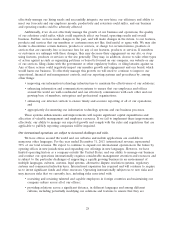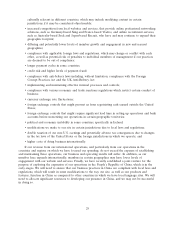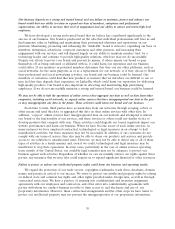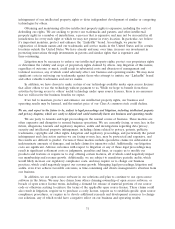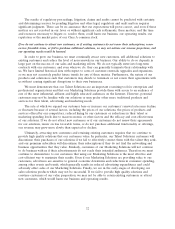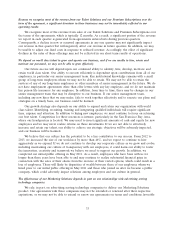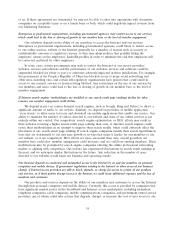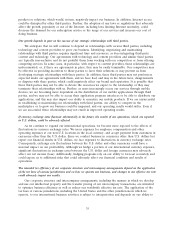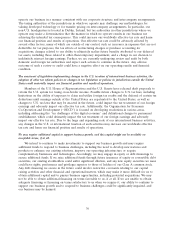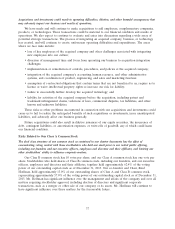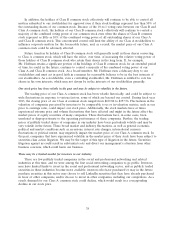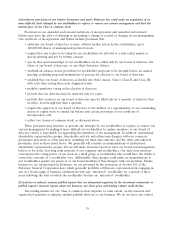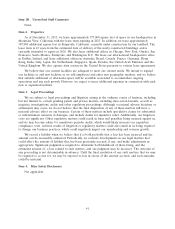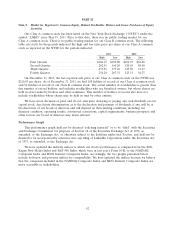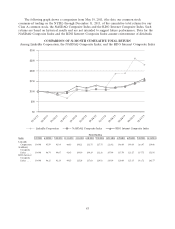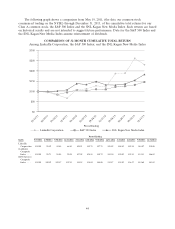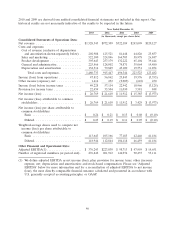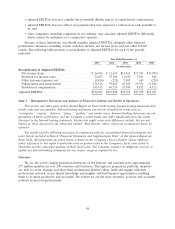LinkedIn 2013 Annual Report Download - page 40
Download and view the complete annual report
Please find page 40 of the 2013 LinkedIn annual report below. You can navigate through the pages in the report by either clicking on the pages listed below, or by using the keyword search tool below to find specific information within the annual report.In addition, the holders of Class B common stock collectively will continue to be able to control all
matters submitted to our stockholders for approval even if their stock holdings represent less than 50% of
the outstanding shares of our common stock. Because of the 10-to-1 voting ratio between our Class B and
Class A common stock, the holders of our Class B common stock collectively will continue to control a
majority of the combined voting power of our common stock even when the shares of Class B common
stock represent as little as 10% of the combined voting power of all outstanding shares of our Class A
and Class B common stock. This concentrated control will limit the ability of our Class A stockholders to
influence corporate matters for the foreseeable future, and, as a result, the market price of our Class A
common stock could be adversely affected.
Future transfers by holders of Class B common stock will generally result in those shares converting
to Class A common stock, which will have the effect, over time, of increasing the relative voting power of
those holders of Class B common stock who retain their shares in the long term. If, for example,
Mr. Hoffman retains a significant portion of his holdings of Class B common stock for an extended period
of time, he could, in the future, continue to control a majority of the combined voting power of our
Class A and Class B common stock. As a board member, Mr. Hoffman owes a fiduciary duty to our
stockholders and must act in good faith in a manner he reasonably believes to be in the best interests of
our stockholders. As a stockholder, even a controlling stockholder, Mr. Hoffman is entitled to vote his
shares in his own interests, which may not always be in the interests of our stockholders generally.
Our stock price has been volatile in the past and may be subject to volatility in the future.
The trading price of our Class A common stock has been volatile historically, and could be subject to
wide fluctuations in response to various factors, some of which are beyond our control. During fiscal year
2013, the closing price of our Class A common stock ranged from $109.80 to $257.56. Fluctuations in the
valuation of companies perceived by investors to be comparable to us or in valuation metrics, such as our
price to earnings ratio, could impact our stock price. Additionally, the stock markets have at times
experienced extreme price and volume fluctuations that have affected and might in the future affect the
market prices of equity securities of many companies. These fluctuations have, in some cases, been
unrelated or disproportionate to the operating performance of these companies. Further, the trading
prices of publicly traded shares of companies in our industry have been particularly volatile and may be
very volatile in the future. These broad market and industry fluctuations, as well as general economic,
political and market conditions such as recessions, interest rate changes, international currency
fluctuations or political unrest, may negatively impact the market price of our Class A common stock. In
the past, companies that have experienced volatility in the market price of their stock have been subject to
securities class action litigation. We may be the target of this type of litigation in the future. Securities
litigation against us could result in substantial costs and divert our management’s attention from other
business concerns, which could harm our business.
There may be a limited market for investors in our industry.
There are few publicly traded companies in the social and professional networking and related
industries at this time, and we were among the first social networking companies to go public. Investors
may have limited funds to invest in the social and professional networking sector, and as publicly traded
securities in these industries become more available, investors who have purchased or may in the future
purchase securities in this sector may choose to sell LinkedIn securities that they have already purchased
in favor of other companies, and/or choose to invest in other companies, including our competitors. As a
result, demand for our Class A common stock could decline, which would result in a corresponding
decline in our stock price.
38


